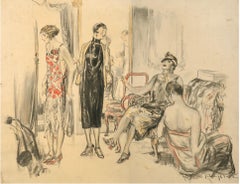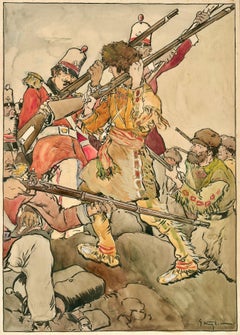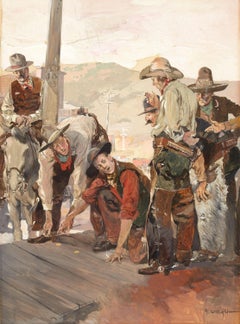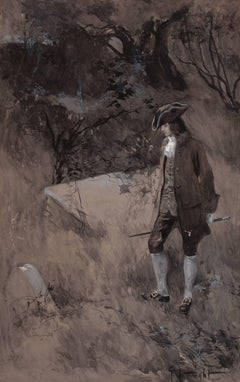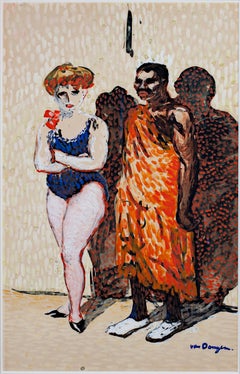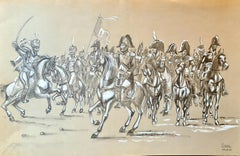George Hand Wright Art
to
4
Overall Width
to
Overall Height
to
4
2
1
3
1
4
4
2
2
1
1
1
4
4
2
2
1
4
10,083
2,775
1,380
1,375
4
4
Artist: George Hand Wright
Young Woman Tries on Gown
By George Hand Wright
Located in Fort Washington, PA
Signed Lower Right by Artist
Magazine story illustration: “Mr. and Mrs. Fixit”, author: Ring Lardner, Liberty Magazine; publisher: (Liberty Weekly, Inc.), Vol. 2, no 1, May 9, 1925.
Category
1920s George Hand Wright Art
Materials
Charcoal, Watercolor
“Kit Carson, The Famous American Frontiersman”
By George Hand Wright
Located in Fort Washington, PA
Medium: Ink and Gouache
Signature: Signed Lower Right
Story illustration for “Kit Carson, The Famous American Frontiersman” by William S. Bridgman for Munsey’s, published December 1...
Category
Early 1900s George Hand Wright Art
Materials
Ink, Gouache
Seats of the Haughty, Munsey's Magazine Illustration
By George Hand Wright
Located in Fort Washington, PA
Medium: Gouache on Board
Signature: Signed Lower Right
Seats of the Haughty, Munsey's Magazine illustration, December 1906
Literature: This illustration appeared in O. Henry's shor...
Category
Early 1900s George Hand Wright Art
Materials
Gouache, Board
Figure in the Forest
By George Hand Wright
Located in Fort Washington, PA
Medium: Watercolor on Board
Dimensions: 23.50" x 15.00"
Signature: Signed Lower Right
Category
20th Century George Hand Wright Art
Materials
Board, Watercolor
Related Items
Kees Van Dongen Circus Performers 1900s Vintage Vibrant Figure Fauvist Signed
By Kees van Dongen
Located in Milwaukee, WI
"Les Artistes du Cirque" is an original painting in ink, watercolor, and gouache on paper by leading Fauvist artist Kees Van Dongen, signed in the lower right. In the piece, two circus performers stand against against a wall. On the left, a pale woman in a blue leotard with red flowers on the shoulder stands with her arms crossed, looking out at the viewer. The painter fills in her tights with delicate white brushstrokes, lending them an almost iridescent appearance. Her strawberry blond hair is piled on top of her hair according to the fashion of the period. On the right, an African man stands in a vivid orange toga, looking somewhere off to the left. His feet are clad in bright white shoes...
Category
Early 1900s Fauvist George Hand Wright Art
Materials
Paper, Ink, Watercolor, Gouache
$2,268,000 Sale Price
20% Off
H 38.5 in W 29.25 in
Napoleon at the Head of His Grande Armée, His Generals and the Prussian Hussars
Located in Cotignac, FR
Pencil, chalk and watercolour depiction of Napoleon at the head of his generals by French artist Jean Ducel. The work is signed bottom right.
A bold and graphic depiction of Napoleo...
Category
Late 20th Century Outsider Art George Hand Wright Art
Materials
Chalk, Crayon, Cardboard, Pencil, Watercolor
Flapping Mallard Ducks Dropping Onto The Mill Stream
Located in Cirencester, Gloucestershire
Artist/ School: Norman A.Olley (British, 20th century) dated 1995 and inscribed verso
Title - Mallards Dropping On The Mill Stream
Medium: gouache/water...
Category
19th Century Victorian George Hand Wright Art
Materials
Ink, Watercolor, Gouache, Pencil
Walpi #4 - Original Semi-Abstract Southwestern Landscape Watercolor Mixed Media
Located in Denver, CO
"Walpi #4" is an original semi-abstract Southwestern landscape by renowned 20th-century artist Bert Van Bork (1928-2014). This captivating watercolor and mixed media painting portrays the dramatic beauty of a Native American Pueblo village nestled on the mesa of First Mesa, Arizona. Van Bork skillfully uses vibrant hues of deep blue, yellow, orange, and pink to convey the cultural richness and natural splendor of the Hopi people. The piece features adobe structures set against the expansive desert sky, merging the artist’s unique style with his deep reverence for Native American heritage.
Presented in a custom white frame with archival materials and UV-protectant glass, the framed artwork measures 8 ½ x 10 ½ x ½ inches, with the image size being 4 ¾ x 7 inches.
Provenance: Estate of Bert Van Bork, Evanston, Illinois
About the Artist:
Bert Van Bork (1928-2014) was a German-born artist, filmmaker, photographer, and writer. Trained under Karl Schmidt-Rottluff in Berlin, he played a significant role in the post-war German art scene before immigrating to the U.S. in 1954. Known for his work as a printmaker and photographer, Van Bork's powerful documentary films earned global recognition, including an Academy Award nomination for EYEWITNESS, the Legacy of Death Camp Art...
Category
21st Century and Contemporary Abstract George Hand Wright Art
Materials
Charcoal, Ink, Watercolor
$675
H 8.5 in W 10.5 in D 0.5 in
Antique Illustration of a Golfer by Listed Illustrator for Vanity Fair
Located in Buffalo, NY
Antique illustration of a golfer getting out of a sand trap by well listed illustrator Leslie Saalburg whose work appeared in Vanity Fair and Esquire.
Category
1910s Realist George Hand Wright Art
Materials
Gouache, Illustration Board
$871 Sale Price
56% Off
H 21 in W 16 in D 0.5 in
St, Louis River Mural Study American Scene Social Realism Mid 20th Century WPA
By Jo Cain
Located in New York, NY
St, Louis River Mural Study American Scene Social Realism Mid 20th Century WPA
Jo Cain (1904-2003)
The Drama of the St. Louis Great River
23 1/4 x 25 ½ inches
Gouache on board c. 19...
Category
1930s American Realist George Hand Wright Art
Materials
Gouache, Board
$15,000
H 34 in W 36 in D 2 in
1960's French Portrait Hunched Old Man Caricature
Located in Cirencester, Gloucestershire
French Character Portrait
French school, Mid 20th Century
Gouache paint on unframed paper
Image : 11 x 10 inches
Superbly decorative 1960's French portrait painting. Ideal for man...
Category
Mid-20th Century Impressionist George Hand Wright Art
Materials
Paper, Ink, Watercolor, Gouache
Simka Simkhovitch WPA Artist Painting Gouache American Modernist Beach Scene
By Simka Simkhovitch
Located in Surfside, FL
Simka Simkhovitch (Russian/American 1893 - 1949)
This came with a small grouping from the artist's family, some were hand signed some were not.
These were studies for larger paintin...
Category
1930s American Modern George Hand Wright Art
Materials
Gouache, Board
Mother and Child
Located in New York, NY
Watercolor on paper laid on board: An exceptional watercolor in terms of quality and presentation. During this earlier period of Day's career he exhibited extensively and was inspir...
Category
1910s Pre-Raphaelite George Hand Wright Art
Materials
Watercolor, Board, Archival Paper
Simka Simkhovitch WPA W/C Painting Gouache American Modernist Beach Scene Nude
By Simka Simkhovitch
Located in Surfside, FL
Simka Simkhovitch (Russian/American 1893 - 1949)
This came with a small grouping from the artist's family, some were hand signed some were not.
These were studies for larger paintin...
Category
1930s American Modern George Hand Wright Art
Materials
Watercolor, Gouache, Board
Mid Century Golden Age of Illustration- Narrative Art - Norman Rockwell School
By Alex Ross
Located in Miami, FL
“Graduation Day” is emblematic of mid-century American Illustration.
But the real story of this storytelling work is that it embodies the lost art of portrait painting and graphic design.
Alex Ross borrows on the classical tradition and flaunts his skills as a narrative painter. In “Graduation Day”, he paints a complex composition involving at least thirteen portraits. The subjects are beautifully rendered and lit. They are set against a dark grey background and jump off the surface at the viewer. The composition is complexly designed. The future graduate in the red jacket engaging with a girl photographer is a compositional device that leads the viewer's eye to the main subject - a father congratulating his son on graduating from medical school. Creating art that relies on facial expressions and body gestures is a talent absent in contemporary art. Why? It’s very hard to do and takes years and training and practice to get it right. Despite Alex Ross's folksy subject matter, this work is a high example of naturalism and representation by an important member of the Golden Age of American Illustration.
Signed lower right
Born in the town of Dunfermline, Scotland, Alexander Sharpe Ross (1908-1990) moved with his family to Pittsburgh, Pennsylvania in 1911. After attending Carnegie Tech (now Carnegie Mellon University), Ross moved to New York and joined the Charles E. Cooper Studio, where he worked among such notable illustrators as Ward Brackett, Stevan Dohanos, J. Frederick Smith...
Category
1940s George Hand Wright Art
Materials
Gouache, Illustration Board
$6,000
H 20.75 in W 19.75 in D 1 in
"Western Wilderness Interior" William Keith, California Tonalist, Forest Stream
By William Keith
Located in New York, NY
William Keith
Western Wilderness Interior
Signed lower left
Watercolor on paper laid on artist board
14 1/2 x 19 inches
A native of Scotland, William Keith became in the late 19th ...
Category
Late 19th Century Tonalist George Hand Wright Art
Materials
Paper, Watercolor, Board
$6,500
H 22.5 in W 28.5 in
George Hand Wright art for sale on 1stDibs.
Find a wide variety of authentic George Hand Wright art available for sale on 1stDibs. You can also browse by medium to find art by George Hand Wright in paint, watercolor, board and more. Not every interior allows for large George Hand Wright art, so small editions measuring 15 inches across are available. Customers who are interested in this artist might also find the work of Walter G. Ratterman, George G. Adomeit, and Morgan Weistling. George Hand Wright art prices can differ depending upon medium, time period and other attributes. On 1stDibs, the price for these items starts at $900 and tops out at $7,900, while the average work can sell for $5,700.
Artists Similar to George Hand Wright
Questions About George Hand Wright Art
- 1stDibs ExpertNovember 20, 2024How much a George Wright painting is worth depends on its size, condition, historical significance and other factors. In 2023, his painting Hounds in a Kennel sold for more than $27,000 at auction in Lexington, Kentucky. He was best known for his hunting and coaching scenes and horse and equestrian portraits. Wright also painted historical subjects, including several small works of Cavaliers. If you own a Wright, a certified appraiser or experienced art dealer can evaluate it. Shop an assortment of George Wright art on 1stDibs.
